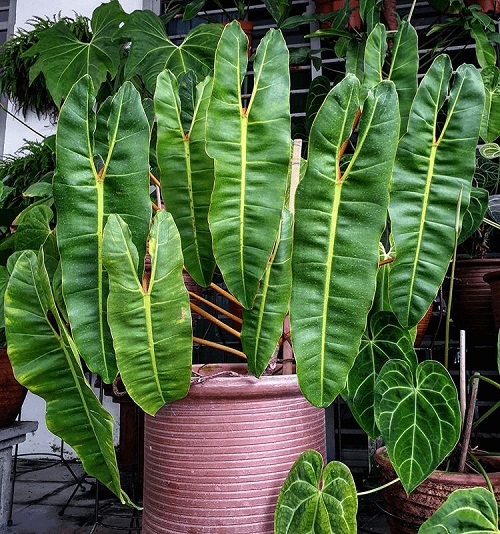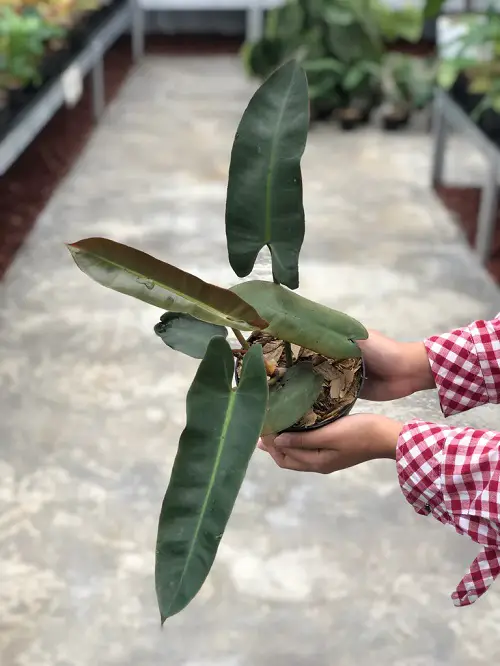Philodendron Atabapoense vs. Billietiae.The battle of the two most beautiful plants you should have in your home!
Philodendron Atabapoense and Billietiae are loved for their distinct leaf shape, growth habits, availability, and care requirements to help you decide what makes them different in the Philodendron Atabapoense vs. Billietiae article.
Have a look at the Philodendron Mayoi Care
What is Philodendron atabapoense?

Native to southern Venezuela to the Amazonian regions in Brazil, Philodendron atabapoense is a climbing plant known for its large, shiny arrow-shaped green leaves with dark maroon undersides and long petioles and its ability to climb and vine.
As a houseplant, Philodendron atabapoense is prized for its attractive foliage and ease of care, growing well in bright, indirect light and well-drained soil.
What is Philodendron Billietiae?
Philodendron billietiae is a hemi-epiphyte species from the Amazon Basin in South America, specifically in Brazil, Guyana, and Suriname. It was first discovered by Freida Billiet in 1981 in the lowland tropical rainforest in French Guiana.
This climbing Philodendron variety features narrow, heart-shaped, glossy, green, thick, leathery leaves up to 10-22 inches long. As a houseplant, it requires bright, indirect light and well-draining soil that is kept consistently moist but not waterlogged.
Similarities Between Philodendron Atabapoense and Philodendron Billietiae
Philodendron atabapoense and Philodendron billietiae are both members of the Philodendron genus and share some similarities:
- Leaf Structure: Both species have long, glossy green leaves with prominent veins and a characteristic cupped shape. The leaves of Philodendron Atabapoense are slightly larger, with a deeper burgundy color on their undersides.
- Growth Habit: Philodendron atabapoense and Philodendron billietiae are vining plants that can grow several feet in length, but they can also be trained to grow upright and compact. They are relatively fast growers and are well-suited for small spaces or use as tabletop plants.
- Light Requirements: Both of these species prefer bright, indirect light but can tolerate some shade. They should not be exposed to direct sunlight, which can cause leaf burn.
- Watering: Philodendron atabapoense and Philodendron billietiae prefer consistently moist soil, but they should not be overwatered. The soil should be allowed to dry out slightly between waterings, and the watering frequency should be adjusted based on the amount of light the plant receives and the time of year.
- Propagation: You can easily propagate both of them from stem cuttings. Simply take a cutting from a mature plant and root it in water or soil.
Differences Between Philodendron Atabapoense and Philodendron Billietiae

The main differences between Philodendron atabapoense and Philodendron billietiae include the following:
- Leaf Color: The main difference between the two is Philodendron atabapoense has purple-burgundy undersides, whereas Philodendron billietiae shows off the green or slightly rose-hued undersides and has orange petioles.
- Leaf Shape: The Philodendron atabapoense produces dark green, arrow-shaped leaves with rich burgundy undersides. On the other side, Philodendron billietiae has large, heart-shaped, wavy leaves with yellow-orange petioles.
- Growth Habit: Philodendron atabapoense is a climbing plant that can reach up to 15-20 feet long or more in its natural habitat, but in homes, it grows up to 6-8 feet tall. Philodendron billietiae grows up to three feet tall with a width of eight inches in a pot in an indoor setting.
Check out Philodendron Lickety Split Care
Conclusion
Apart from a few differences in appearance, both of these species of Philodendron are known for their attractive foliage and ease of care, making them popular choices for indoor gardens. They both prefer bright, indirect light and consistently moist soil and can tolerate lower light levels.




